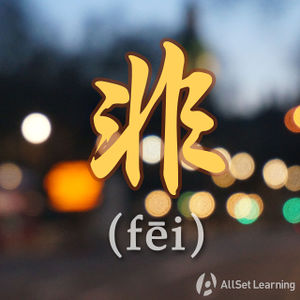Difference between revisions of "Expressing "could it be possible that" with "mofei""
| (2 intermediate revisions by the same user not shown) | |||
| Line 2: | Line 2: | ||
{{stub}} | {{stub}} | ||
| − | + | 莫非 (mòfēi) is generally used at the start of the second clause of sentence. This grammar pattern can express doubt or make a guess It can also be used to ask a rhetorical question, similar to [[Rhetorical Questions with "nandao"|难道 (nándào).]] | |
== Structure == | == Structure == | ||
| Line 22: | Line 22: | ||
*这么 晚 了 他 还 没有 回来,<em>莫非</em> 他 出 了 什么 事 ? | *这么 晚 了 他 还 没有 回来,<em>莫非</em> 他 出 了 什么 事 ? | ||
*桌子 上 那 条 鱼 怎么 不 见 了,<em>莫非</em> 被 猫 偷 吃 了<em>不成</em>? | *桌子 上 那 条 鱼 怎么 不 见 了,<em>莫非</em> 被 猫 偷 吃 了<em>不成</em>? | ||
| − | *<em>莫非</em> 他 | + | *<em>莫非</em> 他 听到 了 我们 的 谈话? |
</div> | </div> | ||
| Line 68: | Line 68: | ||
{{Rel char|非}} | {{Rel char|非}} | ||
{{POS|Sentence patterns}} | {{POS|Sentence patterns}} | ||
| − | {{Used for| | + | {{Used for|Asking rhetorical questions}} |
Latest revision as of 09:00, 10 November 2020
| This article is a stub. Editors can help the Chinese Grammar Wiki by expanding it. |
莫非 (mòfēi) is generally used at the start of the second clause of sentence. This grammar pattern can express doubt or make a guess It can also be used to ask a rhetorical question, similar to 难道 (nándào).
Contents
Structure
When expressing doubt or making a guess, use the following pattern. The 不成 at the end of the sentence is optional. Remember that in this form, the 莫非 is usually at the beginning of the second clause.
Fact, + 莫非 + conjecture + (不成)?
Examples
- 眼前 这个 人,莫非 就是 大名鼎鼎 的 房地产 大亨?
- 这么 晚 了 他 还 没有 回来,莫非 他 出 了 什么 事 ?
- 桌子 上 那 条 鱼 怎么 不 见 了,莫非 被 猫 偷 吃 了不成?
- 莫非 他 听到 了 我们 的 谈话?
Structure
You can use 莫非 the same way you would use 难道: in a rhetorical question. Remember that these questions are to emphasize a point, so they usually aren't meant to be answered.
Subject + 莫非 + rhetorical question
or
莫非 + Subject + rhetorical question
Examples
- 莫非 她 真的 是 你 的 亲生 母亲?
- 莫非 你 真的 相信 他?
- 莫非 他 真的 要 去 丛林 探险?
See also
Sources and further reading
Books
- 现代汉语八百词(p.389) →buy
- Common Chinese Patterns 330 (汉语常用格式330例) (p. 171)→buy



